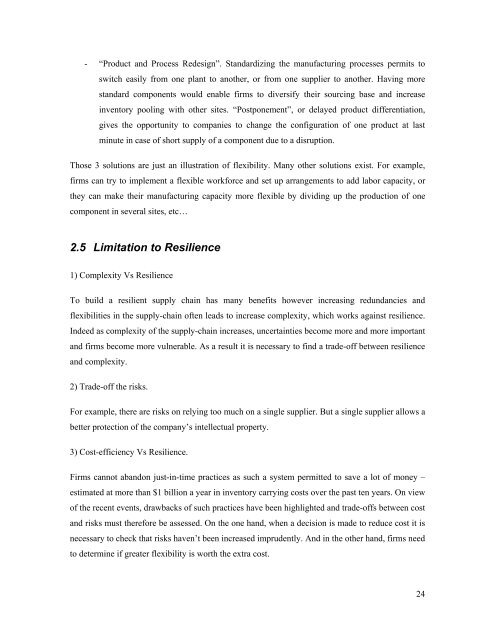Managing Risks of Supply-Chain Disruptions: Dual ... - CiteSeerX
Managing Risks of Supply-Chain Disruptions: Dual ... - CiteSeerX
Managing Risks of Supply-Chain Disruptions: Dual ... - CiteSeerX
You also want an ePaper? Increase the reach of your titles
YUMPU automatically turns print PDFs into web optimized ePapers that Google loves.
- “Product and Process Redesign”. Standardizing the manufacturing processes permits toswitch easily from one plant to another, or from one supplier to another. Having morestandard components would enable firms to diversify their sourcing base and increaseinventory pooling with other sites. “Postponement”, or delayed product differentiation,gives the opportunity to companies to change the configuration <strong>of</strong> one product at lastminute in case <strong>of</strong> short supply <strong>of</strong> a component due to a disruption.Those 3 solutions are just an illustration <strong>of</strong> flexibility. Many other solutions exist. For example,firms can try to implement a flexible workforce and set up arrangements to add labor capacity, orthey can make their manufacturing capacity more flexible by dividing up the production <strong>of</strong> onecomponent in several sites, etc…2.5 Limitation to Resilience1) Complexity Vs ResilienceTo build a resilient supply chain has many benefits however increasing redundancies andflexibilities in the supply-chain <strong>of</strong>ten leads to increase complexity, which works against resilience.Indeed as complexity <strong>of</strong> the supply-chain increases, uncertainties become more and more importantand firms become more vulnerable. As a result it is necessary to find a trade-<strong>of</strong>f between resilienceand complexity.2) Trade-<strong>of</strong>f the risks.For example, there are risks on relying too much on a single supplier. But a single supplier allows abetter protection <strong>of</strong> the company’s intellectual property.3) Cost-efficiency Vs Resilience.Firms cannot abandon just-in-time practices as such a system permitted to save a lot <strong>of</strong> money –estimated at more than $1 billion a year in inventory carrying costs over the past ten years. On view<strong>of</strong> the recent events, drawbacks <strong>of</strong> such practices have been highlighted and trade-<strong>of</strong>fs between costand risks must therefore be assessed. On the one hand, when a decision is made to reduce cost it isnecessary to check that risks haven’t been increased imprudently. And in the other hand, firms needto determine if greater flexibility is worth the extra cost.24
















